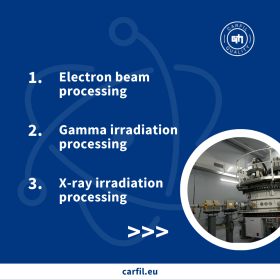- 40 years of experience in special diets for laboratory animals
- Optimal quality
Carfil Quality supports the life science sector
Explained: 3 ways to sterilize diets, bedding or enrichments
At the moment there are 3 ways to sterilize diets, bedding or enrichments. Certain sterilization methods have more advantages than others. Sterilization by gamma and X-ray can be done with full pallets. E-beam can only sterilize pro conditioning. The entire product range of Carfil Quality has been validated in various gamma and X-ray facilities in Europe.
1. Electron beam processing
The electron beam (E-beam) irradiation process uses high-energy electrons for a variety of applications:
- sterilization of single-use medical devices
- contamination control of consumer products
- modification of materials: heat shrink tubing, wire and cables and molded parts
What is electron beam irradiation?
In the electron beam process a product is bombarded with high-energy electrons, resulting in a cascade of these electrons moving through the target material.
What are the benefits of electron beam?
E-beam irradiation can penetrate a wide range of materials and deliver the required irradiating dose in just a few seconds, meaning the entire process can take place in minutes.
2. Gamma irradiation processing
The gamma irradiation process uses Cobalt 60 radiation for a variety of applications, including sterilization, decontamination and materials modification. Gamma irradiation offers good penetration of dense products and is ideal for many types of materials and their packaging.
What is gamma irradiation?
The gamma irradiation process uses Cobalt 60 radiation to kill microorganisms on a variety of different products in a specially designed cell. Gamma radiation is generated by the decay of the radioisotope Cobalt 60, with the resultant high energy photons being an effective sterilant. A key characteristic of gamma irradiation is the high penetration capability, which allows for delivery of target radiation dose to areas of products that may be higher in density.
What are the benefits of gamma irradiation?
Gamma irradiation is safe, reliable and highly effective at treating a wide variety of products with varying densities. With the ability to penetrate products while sealed in their final packaging, gamma irradiation supports the manufacturing and distribution process by facilitating final packaged products as well as raw material needs, ensuring full sterility of the product.
3. X-ray irradiation processing
The X-ray irradiation process utilizes photon radiation for a variety of applications, including sterilization, decontamination and materials modification. The X-ray process is compatible with most materials and provides excellent penetration on dense products.
What is X-ray irradiation?
X-ray starts as an electron beam where electrons are generated and accelerated to gain energy. The X-ray radiation is generated through a process called Bremsstrahlung to create electromagnetic energy (photons) with an energy in the same range as gamma.
What are the benefits of X-ray irradiation processing?
X-ray irradiation is safe, reliable and highly effective at treating a wide variety of products with varying densities. The combination of shorter exposure time and improved Dose Uniformity Ratio (DUR) make X-ray irradiation a viable processing option for a variety of products. Similar to electron beam, X-ray processing is powered by electricity. Benefits of X-ray include:
- Improved penetration ability of photon energy, similar to gamma
- Fast and efficient targeted processing that facilitates scale from carton to full pallets of product
- Flexibility: ability to mix different products with different dose requirements in the same irradiation cycle


